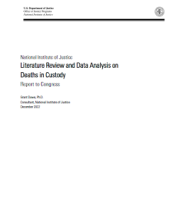Corrections statistics
New Orleans Offender Study: Phase 1, Volume 1: Description of Official Record Data and Coding Process
National Institute of Justice Literature Review and Data Analysis on Deaths in Custody, Report to Congress
Desistance: It's a Process, Not an Event
Desistance From Crime: Implications for Research, Policy, and Practice
Most scholars would agree that desistance from crime – the process of ceasing engagement in criminal activities – is normative. However, there is variability in the literature regarding the definition and measurement of desistance, the signals of desistance, the age at which desistance begins, and the underlying mechanisms that lead to desistance. Even with considerable advances in the theoretical understanding of desistance from crime, there remain critical gaps between research and the application of that research to practice.
See the YouTube Terms of Service and Google Privacy Policy
Crime and Justice Atlas 2000
Three-Year Reincarceration Outcomes for In-Prison Therapeutic Community Treatment in Texas
Using Early Release to Relieve Prison Crowding - A Dilemma in Public Policy
Policies and Imprisonment: The Impact of Structured Sentencing and Determinate Sentencing on State Incarceration Rates, 1978-2004
Cost Effectiveness Analysis of In-Prison Therapeutic Community Treatment and Risk Classification
Results of a Multisite Study of Boot Camp Prisons
Toward a Demographic Understanding of Incarceration Disparities: Race, Ethnicity, and Age Structure
How Are Sex Offenders Managed on Probation and Parole? A National Survey, Final Report
Dual Experiment in Intensive Community Supervision: Minnesota's Prison Diversion and Enhanced Supervised Release Programs
Mass Incarceration, Public Health, and Widening Inequality in the USA
User Accountability and Long-term Recidivism: A Final Report Submitted to the National Institute of Justice
Three-Year Outcomes of Therapeutic Community Treatment for Drug-Involved Offenders in Delaware: From Prison to Work Release to Aftercare
TECHBeat, September 2019
An Examination of Justice Reinvestment and Its Impact on Two States
Funded in part by the Bureau of Justice Assistance and the Pew Center on the States, the justice reinvestment project is a data-driven strategy aimed at policymakers to "reduce spending on corrections, increase public safety and improve conditions in the neighborhoods to which most people released from prison return." Representatives from two states where the justice reinvestment strategy is currently being implemented will discuss how it is being used to reduce the rate of incarceration and how states can reinvest in local communities.



